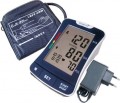—
Shoulder. The classic version of the location of the blood pressure monitor cuff is on the shoulder of the left hand, ideally at the level of the heart. Shoulder arrangement can have tonometers of all types (see above).
—
Wrist. Wrist pressure measurement is found only among automatic models (see "Type"). The main advantage of such models is compactness. On the other hand, they are not recommended for the elderly, and many models are unable to work correctly with arrhythmia or a weak pulse — this point should be clarified separately when buying a device.
Type of power source of the blood pressure monitor. Power is required only for automatic and semi-automatic models (see "Type") — mechanical ones work solely due to the muscular strength of the user.
—
Batteries. The blood pressure monitor is powered by replaceable batteries that have a standard size — for example, AA. Such devices are autonomous, because they do not require a mains connection, and batteries are purchased without problems and are easy to change, unlike
built-in batteries (see below). On the other hand, batteries are usually not included in the package, and you have to buy them regularly, which is associated with corresponding expenses. An alternative is to buy the elements in the form of rechargeable batteries; they are quite expensive, however, having paid once for batteries and a charger, you no longer have to spend money on energy sources. Anyway, all blood pressure monitors with measurement on the wrist (see "Measuring place"), as well as some models of "shoulder" models, are powered by batteries.
— Batteries/mains. These blood pressure monitors offer dual power options, allowing them to operate on both replaceable batteries and a 230 V
network. This versatility enables battery usage in remote locations and the convenience of plugging into the network in more conventional settings to conserve battery life. However, the use of the net
...work requires a power source and adds bulk to the complete set. As a result, this type of power supply is exclusive to blood pressure monitors with measurements on the upper arm.
— Battery. These blood pressure monitors are powered by a proprietary, non-standard battery that is often non-removable. Similar to standard batteries, these power sources provide autonomy, allowing the device to function without nearby outlets. However, recharging the exhausted battery requires an electric source, typically an outlet, and the process is time-consuming. As a result, this power supply type is not widely adopted in blood pressure monitors and is primarily found in compact models where the use of standard batteries is technically impractical.The cuff's applicable range includes both the minimum and
maximum circumferences of the upper arm or wrist (see "Place of measurement"). Modern blood pressure monitors typically feature cuffs suitable for individuals with average physique, covering the majority of adult patients. However, for specialized cases, such as monitoring a child or someone with a larger bicep circumference, it is advisable to measure the arm circumference and compare it with the specified cuff sizes.
—
Small. The small cuffs are designed for a shoulder girth of 17-22 cm.
—
Standard. Standard cuffs cover a shoulder girth of 22-32 cm.
—
Oversized. Oversized cuffs have a girth of 22-36 cm.
—
Universal. Cuffs for both thin and large people. Universal cuffs provide a shoulder girth of 22-42 cm.
—
Large. Large cuffs with a girth of 33-46 cm are suitable for a full arm or a muscular shoulder of a conditional bodybuilder.

